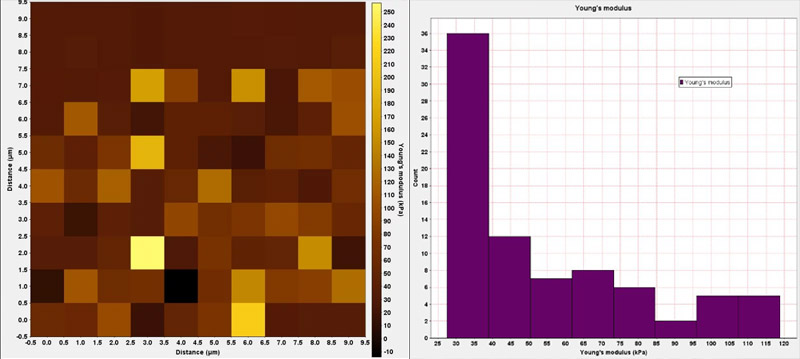Dextran layer characterization by AFM within the framework of the EUSMI project
In this work a dextran layer was examined as a continuation of previous developments for biosensor applications (Nanobiosensorics Laboratory, Budapest, Hungary). There was an increasing need to characterize these dextran coatings in detail by AFM. Although simple AFM measurements have been done on our dextran coatings in a dry state, we aimed at a more detailed characterization in the liquid state that could support our development with additional data.
I applied to the EUSMI (European Soft Matter Infrastructure) for measurement time at the Nanosurf GmbH at Langen, Germany. The focus of our research on dextran coatings is to increase the layer thickness (in the range of 100 nm or larger). The CMD layer was deposited by spin-coating and cross-linker reagent was used to stabilize the thicker layers. One of the main questions about these layers was about the thickness of CMD obtained by optical methods (ellipsometry, OWLS) and to compare it with AFM results. The increased cross-linking density can also contribute to the thicker layer by stabilizing the layer structure and harden the layer at the same time. An interesting property of these dextran hydrogel layers was the elastic characteristic, which is unknown in the literature. We aimed to determine the Young’s modulus of these coatings and devise a preferable future method of deposition to tune this layer parameter, which could be useful for e.g. cell adhesion experiments.
I have performed a series of AFM measurements in dry and wet state of the coatings, simple imaging in contact and tapping mode, and force spectroscopy measurements. During the experiments I was supervised by experts at Nanosurf GmbH, Langen (Drs. Henrik Peisker and Marcus Weth). The laboratory is well equipped for AFM experiments. Lithography experiments were also performed to determine the thickness of the CMD layer giving somewhat smaller values than our optical methods (100-500 nm). The measurements provided a lot of useful data of which an interesting part of elasticity was already presented at the “Jülich Soft Matter Workshop” [1] and a future article is also planned. Our results showed that CMD layers exhibit Young’s modulus in the range of 30 – 200 kPa.
 Figure: Young’s modulus map obtained from a 10×10 µm area and the corresponding distribution (E histogram). Wet measurement.
Figure: Young’s modulus map obtained from a 10×10 µm area and the corresponding distribution (E histogram). Wet measurement.
The application itself to the EUSMI transnational access program was quite smooth and straightforward. After registering through the webpage of EUSMI (https://eusmi-h2020.eu/) the applicant finds information about the application procedure. There is also a step by step description of the application prepared in a presentation format that is very helpful. My personal feeling is that the project proposal should not be lengthy, instead it has to present all the necessary information (background literature, previous results and trials on the field, expected results) in a practical way for the reviewers to judge the proposed work. It is strongly advised to negotiate all the details of the proposed work with the host. The work should be discussed and well prepared before the proposal so that the successful finalization is not at risk (e.g. please be prepared to answer questions about the physical form, dimensions and handling of your samples). After this, the applicant will receive emails about the current state of the proposal from the EUSMI project management from time to time.
In summary I felt this transnational access program to be very helpful for those who do not have access to such instruments at their workplace or are not fully trained to perform such measurements. The administrative work for the application is minimal (as compared to other scientific programs), the whole procedure is transparent and the applicant is continuously kept up to date.
Reference
[1] Elasticity behaviour of dextran coatings studied by AFM, S. Kurunczi, A. Saftics, P. Girnt, H. Peisker, M. Weth, R. Horváth, Jülich Soft Matter Days Workshop, November 20-23, 2018.
Contact
Dr. Sándor Kurunczi
Nanobiosensorics Laboratory, Budapest, Hungary
Email: kurunczi.sandor@energia.mta.hu

